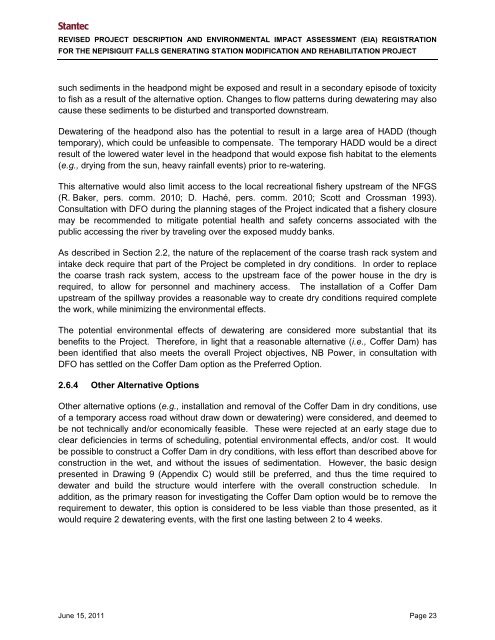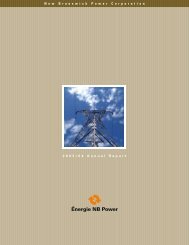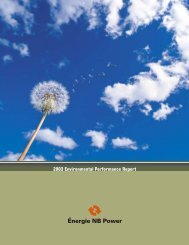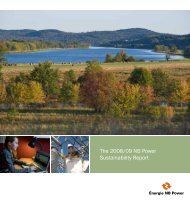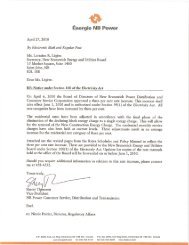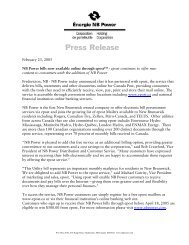Environmental Impact Assessment(EIA) Registration for the ...
Environmental Impact Assessment(EIA) Registration for the ...
Environmental Impact Assessment(EIA) Registration for the ...
Create successful ePaper yourself
Turn your PDF publications into a flip-book with our unique Google optimized e-Paper software.
REVISED PROJECT DESCRIPTION AND ENVIRONMENTAL IMPACT ASSESSMENT (<strong>EIA</strong>) REGISTRATION<br />
FOR THE NEPISIGUIT FALLS GENERATING STATION MODIFICATION AND REHABILITATION PROJECT<br />
such sediments in <strong>the</strong> headpond might be exposed and result in a secondary episode of toxicity<br />
to fish as a result of <strong>the</strong> alternative option. Changes to flow patterns during dewatering may also<br />
cause <strong>the</strong>se sediments to be disturbed and transported downstream.<br />
Dewatering of <strong>the</strong> headpond also has <strong>the</strong> potential to result in a large area of HADD (though<br />
temporary), which could be unfeasible to compensate. The temporary HADD would be a direct<br />
result of <strong>the</strong> lowered water level in <strong>the</strong> headpond that would expose fish habitat to <strong>the</strong> elements<br />
(e.g., drying from <strong>the</strong> sun, heavy rainfall events) prior to re-watering.<br />
This alternative would also limit access to <strong>the</strong> local recreational fishery upstream of <strong>the</strong> NFGS<br />
(R. Baker, pers. comm. 2010; D. Haché, pers. comm. 2010; Scott and Crossman 1993).<br />
Consultation with DFO during <strong>the</strong> planning stages of <strong>the</strong> Project indicated that a fishery closure<br />
may be recommended to mitigate potential health and safety concerns associated with <strong>the</strong><br />
public accessing <strong>the</strong> river by traveling over <strong>the</strong> exposed muddy banks.<br />
As described in Section 2.2, <strong>the</strong> nature of <strong>the</strong> replacement of <strong>the</strong> coarse trash rack system and<br />
intake deck require that part of <strong>the</strong> Project be completed in dry conditions. In order to replace<br />
<strong>the</strong> coarse trash rack system, access to <strong>the</strong> upstream face of <strong>the</strong> power house in <strong>the</strong> dry is<br />
required, to allow <strong>for</strong> personnel and machinery access. The installation of a Coffer Dam<br />
upstream of <strong>the</strong> spillway provides a reasonable way to create dry conditions required complete<br />
<strong>the</strong> work, while minimizing <strong>the</strong> environmental effects.<br />
The potential environmental effects of dewatering are considered more substantial that its<br />
benefits to <strong>the</strong> Project. There<strong>for</strong>e, in light that a reasonable alternative (i.e., Coffer Dam) has<br />
been identified that also meets <strong>the</strong> overall Project objectives, NB Power, in consultation with<br />
DFO has settled on <strong>the</strong> Coffer Dam option as <strong>the</strong> Preferred Option.<br />
2.6.4 O<strong>the</strong>r Alternative Options<br />
O<strong>the</strong>r alternative options (e.g., installation and removal of <strong>the</strong> Coffer Dam in dry conditions, use<br />
of a temporary access road without draw down or dewatering) were considered, and deemed to<br />
be not technically and/or economically feasible. These were rejected at an early stage due to<br />
clear deficiencies in terms of scheduling, potential environmental effects, and/or cost. It would<br />
be possible to construct a Coffer Dam in dry conditions, with less ef<strong>for</strong>t than described above <strong>for</strong><br />
construction in <strong>the</strong> wet, and without <strong>the</strong> issues of sedimentation. However, <strong>the</strong> basic design<br />
presented in Drawing 9 (Appendix C) would still be preferred, and thus <strong>the</strong> time required to<br />
dewater and build <strong>the</strong> structure would interfere with <strong>the</strong> overall construction schedule. In<br />
addition, as <strong>the</strong> primary reason <strong>for</strong> investigating <strong>the</strong> Coffer Dam option would be to remove <strong>the</strong><br />
requirement to dewater, this option is considered to be less viable than those presented, as it<br />
would require 2 dewatering events, with <strong>the</strong> first one lasting between 2 to 4 weeks.<br />
June 15, 2011 Page 23


